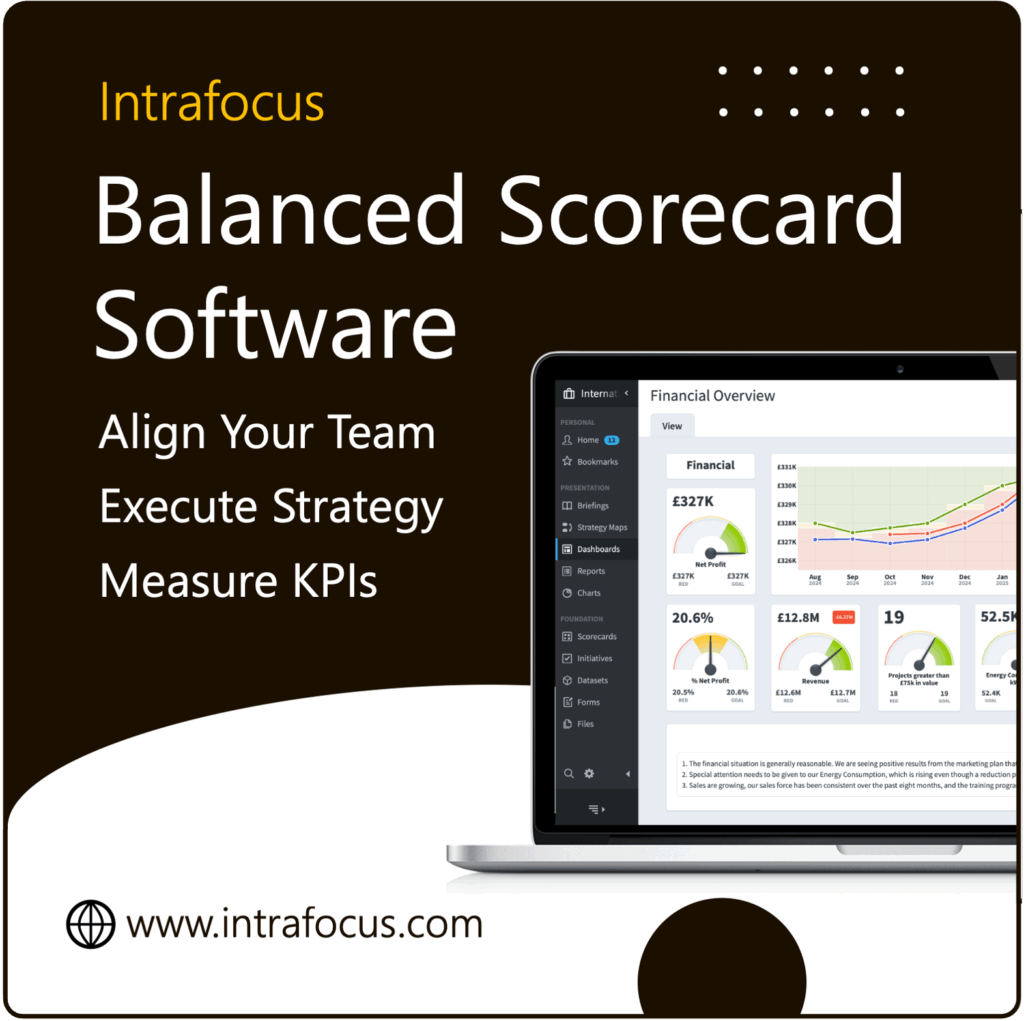Developing a Balanced Scorecard is a powerful way to help organisations align their activities with their vision and strategy. This framework, created by Robert Kaplan and David Norton, enables businesses to monitor performance across multiple perspectives, ensuring a balanced approach to achieving goals. A well-designed Balanced Scorecard can provide significant advantages, such as improved communication, better strategic planning, and enhanced performance tracking. This article explores the top seven things to keep in mind when developing a Balanced Scorecard. From strategic alignment and clear objectives to stakeholder engagement and adaptability, these key considerations will help you create a robust and effective Balanced Scorecard tailored to your organisation’s needs. Whether you are new to this concept or looking to refine your existing scorecard, these insights will guide you in leveraging this tool for sustained success.
Strategic Alignment
Strategic alignment is crucial when developing a Balanced Scorecard. It ensures that all organisational activities are directed toward the company’s goals and vision. This alignment helps bridge the gap between strategic planning and execution, enabling a cohesive effort across different departments and teams.
To achieve strategic alignment, the first step is to clearly define the organisation’s mission, vision, and strategic objectives. These elements form the foundation upon which the Balanced Scorecard is built. Each objective on the scorecard should directly contribute to achieving the strategic goals, ensuring that every effort is purposeful and goal-oriented.
For example, suppose a company’s strategic goal is to enhance customer satisfaction. In that case, the Balanced Scorecard should include objectives and metrics that reflect this priority, such as improving customer service response times or increasing customer feedback scores. The company can effectively monitor and drive progress toward its primary goals by aligning these specific objectives with the broader strategy.
Moreover, strategic alignment fosters a sense of unity and purpose within the organisation. Employees who understand how their roles contribute to the larger mission are more likely to be motivated and engaged. Regular communication and reviews are essential to maintain this alignment, allowing for adjustments as the business environment evolves. This continuous alignment ensures that the Balanced Scorecard remains relevant and effective in guiding the organisation toward its strategic objectives.
Clear Objectives and Metrics
Setting clear objectives and metrics is fundamental to the success of a Balanced Scorecard. These objectives and metrics provide a roadmap for the organisation, outlining specific targets and measurable outcomes that align with the strategic goals.
Clear objectives should be SMART: Specific, Measurable, Achievable, Relevant, and Time-bound. This approach ensures that each objective is well-defined and attainable within a specific timeframe. For instance, instead of setting a vague goal like “improve customer satisfaction,” a SMART objective would be to “increase customer satisfaction scores by 10% within the next year.”
Metrics, or Key Performance Indicators (KPIs), are the tools used to measure progress toward these objectives. Selecting the right metrics is crucial; they must be directly linked to the objectives and provide meaningful insights into performance. For example, if the objective is to enhance customer satisfaction, relevant metrics might include Net Promoter Score (NPS), customer retention rates, and the number of customer complaints.
It’s also essential to ensure that metrics are not overly complex or difficult to track. Simplicity and clarity in measurement allow for easier monitoring and analysis, enabling timely decision-making and adjustments.
By setting clear objectives and selecting appropriate metrics, organisations can effectively track progress, identify areas for improvement, and achieve their strategic goals. This clarity helps maintain focus and direction, ensuring that all efforts contribute to the business’s overall success.
Stakeholder Engagement
Engaging stakeholders is a vital component of developing a successful Balanced Scorecard. Stakeholders, including employees, managers, customers, and investors, bring diverse perspectives and valuable insights that can enhance the scorecard’s effectiveness and relevance.
Involving key stakeholders from the outset ensures their buy-in and commitment to the Balanced Scorecard process. Companies like Intrafocus can provide consultants as facilitators for workshops, meetings, and surveys, where stakeholders can share their expectations, concerns, and suggestions. By incorporating their input, organisations can create a more comprehensive and realistic scorecard that reflects the needs and priorities of all parties involved.
Effective stakeholder engagement fosters a sense of ownership and accountability. When stakeholders understand how their contributions impact the organisation’s strategic goals, they are more likely to be motivated and proactive. This collective commitment is crucial for successfully implementing and maintaining the Balanced Scorecard.
Moreover, transparent communication with stakeholders is essential. Regular updates on progress, challenges, and achievements help maintain trust and alignment. Providing stakeholders with clear, accessible reports and dashboards ensures they are informed and can offer timely feedback.
By actively engaging stakeholders, organisations can build a Balanced Scorecard that is not only aligned with strategic objectives but also supported and driven by the collective effort of everyone involved. This collaborative approach enhances the scorecard’s effectiveness and fosters a culture of continuous improvement and shared success.
Adaptability
Adaptability is a crucial characteristic of a practical Balanced Scorecard. In today’s fast-paced and ever-changing business environment, organisations must be ready to pivot and adjust their strategies and performance measures in response to new challenges and opportunities. A rigid scorecard can quickly become obsolete, whereas a flexible one can evolve with the business.
To ensure adaptability, regularly reviewing and updating the Balanced Scorecard is crucial. This involves periodic assessments of the relevance and effectiveness of the objectives and metrics. As market conditions, competitive landscapes, and internal priorities shift, the scorecard should be adjusted to reflect these changes. For example, a company might shift its focus from aggressive growth to cost management and efficiency during an economic downturn.
Engaging stakeholders in this review process is essential. Their insights can highlight emerging trends, potential risks, and areas for improvement that may not be immediately apparent. This collaborative approach ensures that the scorecard remains aligned with the organisation’s strategic objectives and business context.
Additionally, leveraging technology can enhance adaptability. Automated data collection and real-time analytics allow quicker identification of performance trends and issues, enabling more timely adjustments. By integrating adaptable processes and tools, organisations can maintain a dynamic and responsive Balanced Scorecard that drives sustained success and resilience in the face of change.
Continuous Monitoring
Continuous monitoring is essential for the success of a Balanced Scorecard, ensuring that the organisation remains on track to achieve its strategic objectives. Regularly tracking and reviewing performance metrics allows businesses to identify trends, detect issues early, and make informed decisions.
Organisations should establish a routine for reviewing their Balanced Scorecard to implement continuous monitoring effectively. This could involve weekly, monthly, or quarterly meetings where key stakeholders assess progress, discuss challenges, and adjust strategies as needed. These reviews should focus on both short-term results and long-term trends, providing a comprehensive view of the organisation’s performance.
Utilising technology can significantly enhance the monitoring process. Automated data collection tools and real-time dashboards provide up-to-date information, making tracking key performance indicators (KPIs) continuously easier. This real-time visibility enables swift action in response to emerging issues or opportunities, ensuring that the organisation can adapt quickly to changes in the business environment.
Moreover, continuous monitoring promotes a culture of accountability and transparency. When employees and managers regularly review performance data, they are more likely to stay aligned with the organisation’s goals and take ownership of their contributions. This ongoing engagement helps maintain focus and drive improvement across all business areas.
By prioritising continuous monitoring, organisations can ensure that their Balanced Scorecard remains a dynamic and effective tool for strategic management, driving sustained performance and success.
Integration with Technology
Integrating technology with the Balanced Scorecard is essential for modern organisations looking to enhance efficiency, accuracy, and effectiveness in their strategic management processes. Leveraging technological tools can streamline data collection, analysis, and reporting, making it easier to monitor and manage performance.
One of the primary benefits of integrating technology is the ability to automate data collection. With software solutions and cloud-based platforms, organisations can gather real-time data from various sources without manual intervention. This automation reduces the risk of errors and ensures that the data used for performance measurement is accurate and up-to-date.
Advanced analytics tools can further enhance the Balanced Scorecard by providing deeper insights into performance trends and potential areas for improvement. These tools can help organisations identify patterns, predict future outcomes, and make data-driven decisions. For instance, predictive analytics can forecast market trends, enabling proactive strategy adjustments.
Interactive dashboards and reporting tools are also crucial components of technological integration. These platforms offer intuitive interfaces that allow users to visualise performance data through graphs, charts, and other visual aids. Stakeholders can easily access and interpret this information, facilitating informed decision-making and effective organisational communication.
By integrating technology with the Balanced Scorecard, businesses can achieve greater agility, responsiveness, and strategic alignment. This technological synergy not only enhances the scorecard’s functionality but also empowers organisations to drive continuous improvement and achieve their long-term objectives efficiently.
Developing a Balanced Scorecard
Developing a Balanced Scorecard is a multifaceted process that requires careful consideration of various factors to ensure effectiveness. Organisations can create a robust tool that drives performance and achieves strategic goals by focusing on strategic alignment, clear objectives and metrics, stakeholder engagement, adaptability, continuous monitoring, and technology integration.
These seven key considerations will help you build a Balanced Scorecard tailored to your organisation’s unique needs, ensuring that it remains relevant and impactful in an ever-changing business environment. Remember, the success of a Balanced Scorecard lies in its ability to evolve with the organisation, providing a clear and consistent framework for measuring and managing performance.
To further enhance your understanding and skills in strategic management, we invite you to watch the Intrafocus Academy video, “How to Run a Strategy Workshop.” This video provides valuable insights and practical tips on effectively conducting strategy workshops, a critical step in the Balanced Scorecard development process. Visit Intrafocus Academy to access the video and take your strategic planning skills to the next level.
By applying the principles discussed in this article and leveraging the resources available, you can create a Balanced Scorecard that drives your organisation’s success and fosters a culture of continuous improvement.



